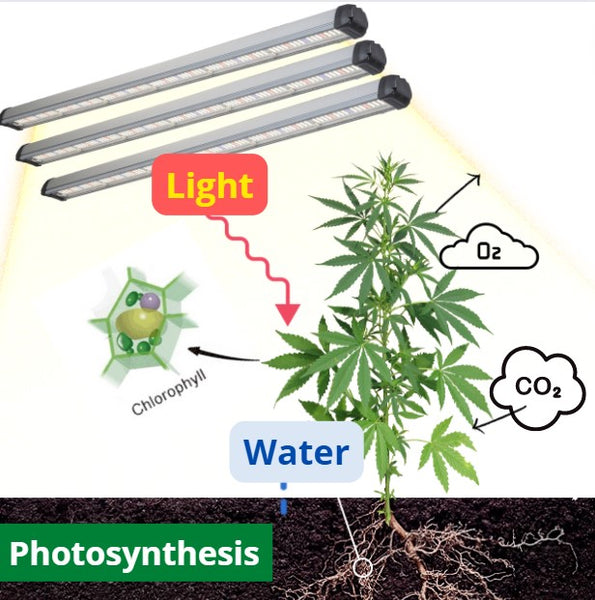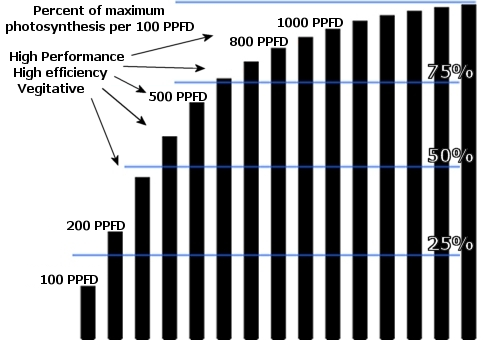The most common question of any cannabis cultivation project is “How much light do my plants need?” When you ask this question and begin the journey of visualizing your grow project, you may become overwhelmed with unfamiliar terms. Daily Light Interval (DLI), Photosynthetic Active Radiation (PAR), Photosynthetic Flux Density (PPFD), are the most common phrases and acronyms used by experts in the grow light industry. By understanding the descriptions of light prior to setting up your grow, you will be one step closer to growing the highest yielding cannabis on your farm while optimizing your energy consumption and light production.
Keep in mind numerous other factors will determine how well your harvest will be for your cultivation system. As we dive into the most important points growers need to consider in cannabis light requirements, we will better define Daily Light Interval (DLI), Photosynthetic Active Radiation (PAR), and Photosynthetic Flux Density (PPFD). This will only cover the amount of light required in an indoor grow for optimized cannabis cultivation. We will cover an outdoor grow in a later post. With this tell-all post, you will maximize the lighting for better plant production which will result in a better harvest, increased yields, and correct crop turnover.
What is Light Intensity?
To better understand the how much light is needed for a crop turn of cannabis indoors we must better understand the photosynthetic pathway and what light intensity is. Light intensity levels directly affect the rates of photosynthesis for your plants. Knowing the target ranges for what stage your plant is in is crucial to maximizing your grow and understanding the conditions necessary for optimal yields, crop turns, and plant health.

Interestingly enough plant and person lighting is not one in the same. The light energy unit that is required for humans is measured in lumens (lux – lumens per square meter) while in plants Photosynthetic Active Radiation (PAR) Photosynthetic photon flux density (PPFD – micromoles per second per square meter (μmol/s-m2)).
Photosynthesis
A simple overview of photosynthesis is the chemical process plants need to undertake to convert light into food in plants, without light plants cannot produce the growth needed to create terpenes, cannabinoids, and the medicine that we all aim for at the end of harvest.
There is such thing as too much light, too much can saturate and burn your plants, too little and the plant development will be stunted or lagging behind. The graphic depicts artificial LED light shining on to a vegetatively growing cannabis plant while water is absorbed by the plant with the process of osmosis in the soil horizon through the root hairs. As the water is moves soluble microscopic nutrients through the small neural like network of mycorrhizae mycelium, oxygen (O2) and carbon dioxide (O2) pass through the plant tissue and through stomata of the plants leaf tissue and produce energy for the plant to grow new branches and nodes from the sugar that was formed as a result of light. All this energy is a result of the photosynthesis and requires a precise amount of light, the right duration of light, and the right quality of light or correct spectrum of light.
Lumen Optimization
Interestingly enough plant and human lighting is not one in the same. The light energy unit that is required for humans is measured in lumens (lux – lumens per square meter) while in plants Photosynthetic Active Radiation (PAR) Photosynthetic photon flux density (PPFD – micromoles per second per square meter (μmol/s-m2)).
Lumens are a unit of measurement that initially measure the radiant power of the light. This is expressed in the amount of light emitted per second from a particular source of light. The lumens required by cultivators is determined by cultivar, plant growing area, distance from the canopy and photon source, and growth stage. This is relative to what the human eye can see and is sensitive to. Between the range that visible to the human eye and has no connection to the photosynthetic pathway of plants while anything lower or greater than that range is not visible to us. To optimize this unit of measurement for your light requirements you need to measure your plants area per square foot or square foot per plant grow site or footprint.
Minimum light requirements on any plant should be 2000 lumens per square foot and approximately 10,000 lumens per square foot on the maximum light requirement.
What is Daily Light Integral?
The daily light integral or DLI is a measure of the aggregate amount of photosynthetically active radiation or PAR light that a surface receives over the course of a day (24 hours DUH). These units of measurement are critical indicates to manage over the course of any grow.

During different seasons natural light intensity fluctuate throughout the day due to time of year, cloud cover, and weather patterns. By completely controlling the lighting (indoors) or adding supplemental lighting (greenhouse or outdoors) you can ensure that optimal growing conditions are met in your environment and mostly importantly ensure your plants are getting the appropriate light for their growing stage.
Example of DLI
DLI is a more important tool when you can utilize sunlight in your greenhouse grow and it is not as important indoor cultivation systems you are talking about the difference in lighting application between vegetative and flowering growth. For example, the photoperiod for vegetative growth is 18 hours, and during flowering it is 12. Let’s say during vegetative growth you applied 500 micromoles per metered square per second (PPFD) for 18 hours resulting in a DLI of 32 while your 12-hour photoperiod only results in a DLI of 21 at the same light density.
DLI Photoperiod Requirements (5 annual crop turns)
| Time | Intensity | Duration per Day (hours) | PPFD μmol m-2s-1 |
| Seedling Stage Weeks 1-3 |
13-19 moles | 18 hours | 200-300 |
| Vegetative Stage Weeks 4-6 |
20-35 moles | 18 hours | 300-600 |
| Flowering Stage Weeks 7-10 |
25-39 moles | 12 hours | 600-900 |

Photosynthetic Photon Flux Density (PPFD)
The par defining range for Photosynthetic Photon Flux Density or PPFD is between 300-900nm. 300-900nm is used by plants for photosynthetic growth and is a more specific range of the light spectrum for horticulture than lumens which is the range of light visible to the human eye. PPF is the total amount of PAR photons a panel emits and is measured by the manufacturer in one of those fancy spheres. But PPF is not exactly reflective of how many photons are hitting your canopy. Handheld PAR meters are measuring PPFD, which is the amount of par photons hitting a square meter per second.
DLI is expressed in terms of moles of light per square meter per day or over a 24-hour period. This metric can directly relate to plant growth, development, yield, and crop quality. Utilizing this standard can help you optimize conditions and maximize your minimum and maximum thresholds for your grow and your budget. DLI is measured with two units of measurement, the micromole (μmol) and photosynthetic photon flux density (PPFD) Micromole (μmol) is the measurement unit for PPFD and measures over a square meter each second.
PPFD refers to the light intensity that your plants receive in micromoles per square meter per second. These parameters are stronger when measured closer to your light source of the grow system and drop when they are farther.
PPFD values are more intense when they are closure to the grow light source and gradually loses its intensity as the source of light transmissions end path. You can utilize the grow intensity charts to see how much PPFD you should expect your plants to get.

As you can see you will need various light intensities as your plant grows and ages through the different cycles of growth. By measuring these units of light, you can make sure your plant has sufficient light penetrating through the canopy.
With the right lighting, several canna strains can easily flower in less than specified lighting times. And with the extra illumination, these crops could surpass expectations. Budding, vegetation, and other stages get direct boosts from proper lighting.
Measuring how much light your crops need to grow makes it a lot easier to streamline your grow effort. Since you have an idea of what’s needed for better lighting, getting a bigger ROI becomes easier.
Cannabis requires a particular spectrum of light throughout each cultivation stage. And cultivators need to apply a different level of lighting throughout the cropping period. To assure optimal yield, monitoring DLI levels is important in three phases of the cycle – infancy, vegetation, and flowering.
Keep in mind that the more light your canopy receives, the bigger your plants will grow during the vegetative stage. So, you must dial in your other environmental, nutrient, and IPM controls accordingly so you can bring big, bud-filled plants to the flowering stage and bring in the money.
If you missed Lesson 4: Vegetative & Flowering Light Cycles, click the link and refresh yourself on taking the first steps to creating more yields and optimizing your grow from the start.
 Thanks for reading and please visit our shop to get started on your grow and stay social with us and reach out to our team if you have any questions about your soil and fertilizer needs.
Thanks for reading and please visit our shop to get started on your grow and stay social with us and reach out to our team if you have any questions about your soil and fertilizer needs.Learn more about Comanche Compost Co. and stay up to date with other giveaways and cultivation pop up events around you!


